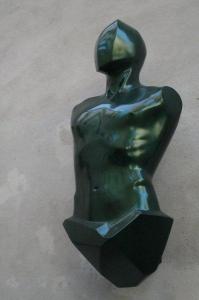This buff metallic chest belongs to none other than Lembitu, the first known person to have fallen Eesti eest – for Estonia in 1217. This is a new interpretation to be sure; made of fiberglass (klaasfiiber) in 2011 by 32 year-old local artist Bruno Lillemets and is hanging outdoors on the wall of the Estonian Ajaloo (History) Museum's courtyard. What you unfortunately cannot see in black and white newsprint is that this Lembitu is a wonderful emerald green. Do you know what Lembitu means?
First of all, do you know what emerald is in Estonian, and a bunch of other languages as well for that matter? It's a wild word, whose letters can easily get switched around – smaragd (!) from the Greek smaragdos meaning "green gem". If you look closely, it's not too far a cry from the so-called Vulgar (i.e. nonstandard) Latin Esmaralda / Esmaraldus, which is only a short hop away from emerald.
So you know WHO Lembitu was – an ancient Estonian elder of Sakala County and military leader in the struggle against conquest of Estonian lands by the German Livonian Brothers of the Sword at the beginning of the 13th century. He is the only Estonian pre-Crusade ruler about whom some biographical information is known (he is mentioned in the Chronicle of Henry of Livonia / Henriku Liivimaa Kroonika). Lembitu attempted to unite the Estonians in order to withstand the German conquest. He managed to assemble an army of 6,000 Estonian men from different counties, but was killed in the following Battle of St. Matthew's Day / Madisepäeva lahing in September 1217. Having battled for national independence, he began garnering interest during the period of Estonian national awakening (mid 19th century) and became a bona fide national hero through fiction.
What's really beautiful is that Lembitu means armastatu – beloved. Lemb, lembus, lemme are all terms for affection aka LOVE and so too are the derived names Lembit (male) and Lembi, Lembe, Lemme, Lemmi and the like – currently perceived as women's names, but once upon a time they were men's names as well, or actually unisex, as were most ancient Estonian names.
If you love history you're an ajaloo/lemb, if kindergarten teacher is your profession, that's surely a case of laste/lembus (love for children).
There is a more traditional, old sculpture of Lembitu in Suure-Jaani in Viljandimaa County and Lembitu's sword stands in stone (granite of the Canadian Shield) at Kotkajärve. This modern, robotic-romantic (as opposed to rahvus/romantiline or idealistically nationalistic) interpretation awaits you in Tallinn's Old Town. He's looking longingly towards the lit (warm) windows of the History Museum's home, the newly renovated Suurgildi hoone or Great Guild Hall.

Name that superhero
Kultuur
TRENDING



























